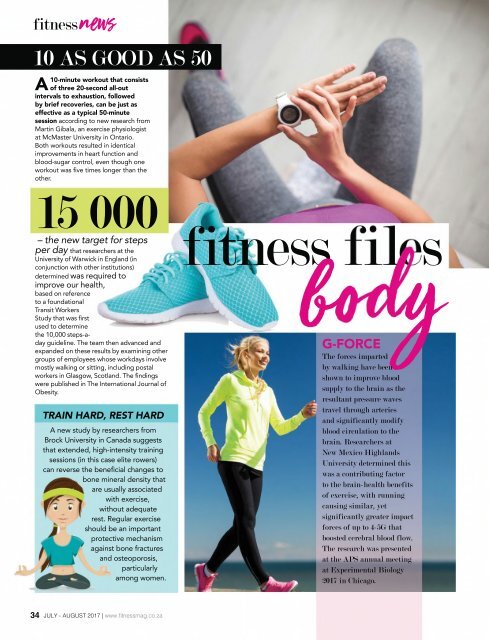Fitness_South_Africa_JulyAugust_2017
Create successful ePaper yourself
Turn your PDF publications into a flip-book with our unique Google optimized e-Paper software.
fitnessnews<br />
10 AS GOOD AS 50<br />
A10-minute workout that consists<br />
of three 20-second all-out<br />
intervals to exhaustion, followed<br />
by brief recoveries, can be just as<br />
effective as a typical 50-minute<br />
session according to new research from<br />
Martin Gibala, an exercise physiologist<br />
at McMaster University in Ontario.<br />
Both workouts resulted in identical<br />
improvements in heart function and<br />
blood-sugar control, even though one<br />
<br />
other.<br />
15 000<br />
– the new target for steps<br />
per day that researchers at the<br />
University of Warwick in England (in<br />
conjunction with other institutions)<br />
determined was required to<br />
improve our health,<br />
based on reference<br />
to a foundational<br />
Transit Workers<br />
<br />
used to determine<br />
the 10,000 steps-aday<br />
guideline. The team then advanced and<br />
expanded on these results by examining other<br />
groups of employees whose workdays involve<br />
mostly walking or sitting, including postal<br />
<br />
were published in The International Journal of<br />
Obesity.<br />
TRAIN HARD, REST HARD<br />
A new study by researchers from<br />
Brock University in Canada suggests<br />
that extended, high-intensity training<br />
sessions (in this case elite rowers)<br />
<br />
bone mineral density that<br />
are usually associated<br />
with exercise,<br />
without adequate<br />
rest. Regular exercise<br />
should be an important<br />
protective mechanism<br />
against bone fractures<br />
and osteoporosis,<br />
particularly<br />
among women.<br />
fitness<br />
s<br />
b y<br />
G-FORCE<br />
The forces imparted<br />
by walking have been<br />
shown to improve blood<br />
supply to the brain as the<br />
resultant pressure waves<br />
travel through arteries<br />
and significantly modify<br />
blood circulation to the<br />
brain. Researchers at<br />
New Mexico Highlands<br />
University determined this<br />
was a contributing factor<br />
to the brain-health benefits<br />
of exercise, with running<br />
causing similar, yet<br />
significantly greater impact<br />
forces of up to 4-5G that<br />
boosted cerebral blood flow.<br />
The research was presented<br />
at the APS annual meeting<br />
at Experimental Biology<br />
<strong>2017</strong> in Chicago.<br />
34<br />
JULY - AUGUST <strong>2017</strong> |

















